Modest Mussorgsky - The Nursery (1956)
Modest Mussorgsky - The Nursery (1956)

1. S Nianei (With Nanny) 2. V Uglu (In the Corner) 3. Zhuk (The Beetle) 4. S Kukloi (With the Doll) 5. Na Son Griaduschii (At Bedtime) 6. Kot Matros (Matros the Cat) 7. Poehal Na Palochke (Riding on a Hobby-Horse)
Nina Dorliac – soprano
Sviatoslav Richter - piano
This is an immensely sophisticated and masterful song cycle. Mussorgsky was one of the first composers to fashion music from speech patterns, and in least one of the songs in this collection, "The Nanny," that technique is in evidence. He first began to develop this method with the songs "Darling Savishna," "You Drunken Sot," and "The Seminarist," all from 1866. But what Mussorgsky was striving for in "The Nanny" goes beyond mere reproduction of speech sounds: he attempts to express musically the feelings and ideas of the child.
The composer used his own texts in this cycle and the subject matter, of course, deals with the world of children, as the titles of the seven songs suggest: 1) "With Nanny," 2) "In the Corner," 3) "The Beetle," 4) "With the Doll," 5) "At Bedtime," 6) "Riding on a Hobby-Horse," and 7) "Matros the Cat" (also translated as "Sailor the Cat"). Yet, the music is not for children; it is formally, thematically, and harmonically as advanced as almost anything in its genre from that era. In certain ways, these songs are a vocal parallel to Schumann's keyboard collection Kinderszenen (Scenes of Childhood) (1838), which also represents an adult view of a children's world. But Mussorgsky's effort here was even more innovative and radical in its time than Schumann's work.
As suggested above, the first song in the cycle, "The Nanny," is the most iconoclastic. It was written just before Mussorgsky embarked on his operatic masterpiece Boris Godunov. In "The Nanny," the composer shatters all convention in the realm of song as he depicts an anxious, talkative child in music that pays little heed to thematic, harmonic, and rhythmic traditions. He makes the listener feel the text in vivid, lifelike sounds. In one passage the nervous child intones: "Nanny dear! Surely the reason the bogeyman ate the children is because they were bad to their old nanny, and they didn't listen to their daddy and mommy...." The music is powerful and touching throughout, the words realistic and innocent, the effect astonishing. All this Mussorgsky achieves, and yet the song is the shortest in the collection, typically taking less than two minutes in a performance.
While most of the other items in the set are nearly as effective, they are not quite as uncompromising and are more lyrically inclined. No. 4, "With the Doll," is an attractive lullaby, but with the child acting the role of the Nanny to the "Dolly." The fifth, "At Bedtime," is a prayer of sorts, with the child delightfully rattling off names of aunts and uncles for God to watch over. While humor is sprinkled throughout most of the songs, two in particular that divulge this trait are No. 2, "In the Corner," in which the child pleads innocent to accusations of mischief to his Nanny, then gradually turns bold with her diminishing anger, and No. 6, "Riding on a Hobby-Horse," in which the child animatedly pretends to be riding a toy horse. Nos. 3 ("The Beetle") and 7 ("Matros the Cat") divulge an agitation in the music to accompany the child's adventures with an insect and a pet cat, respectively.
Though less known than Mussorgsky's operas and not often performed in the West due to the language barrier, this must be regarded as among the most important song cycles from the later nineteenth century. ---Robert Cummings, Rovi
download: uploaded yandex 4shared mediafire solidfiles mega gett filecloudio nornar ziddu
Zmieniony (Sobota, 01 Marzec 2014 12:27)








